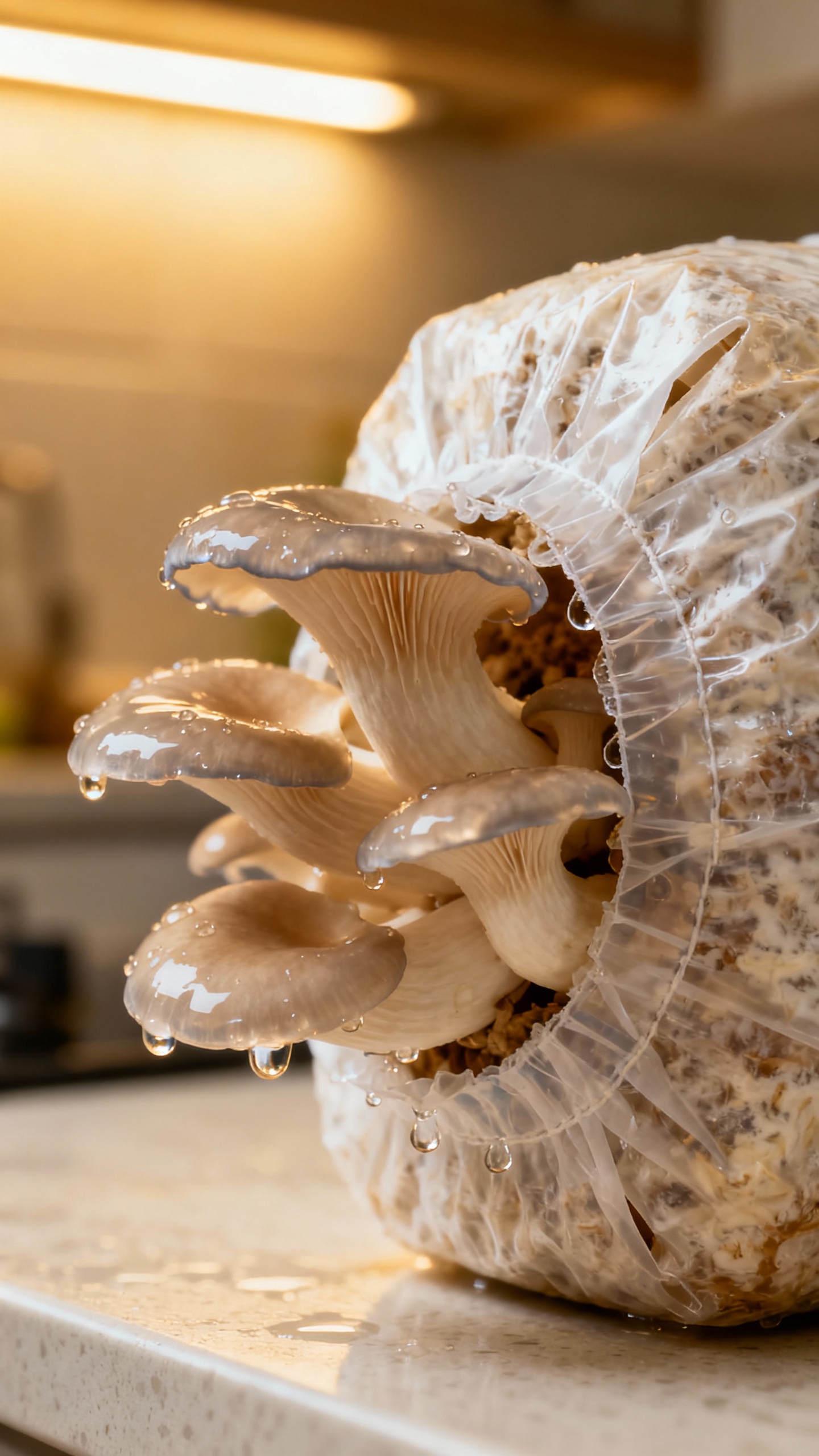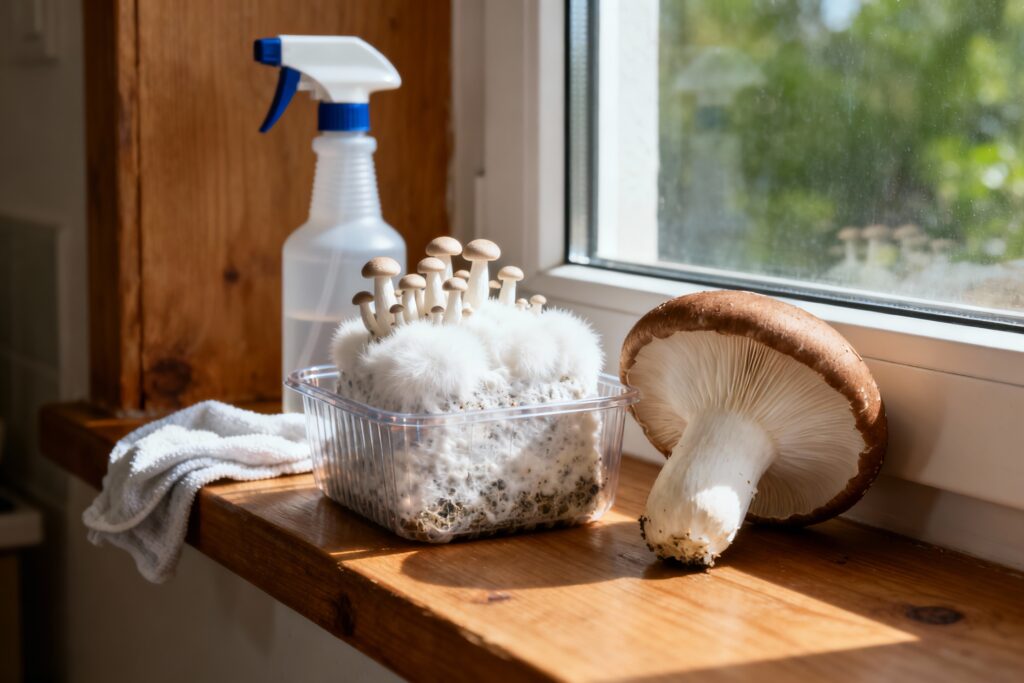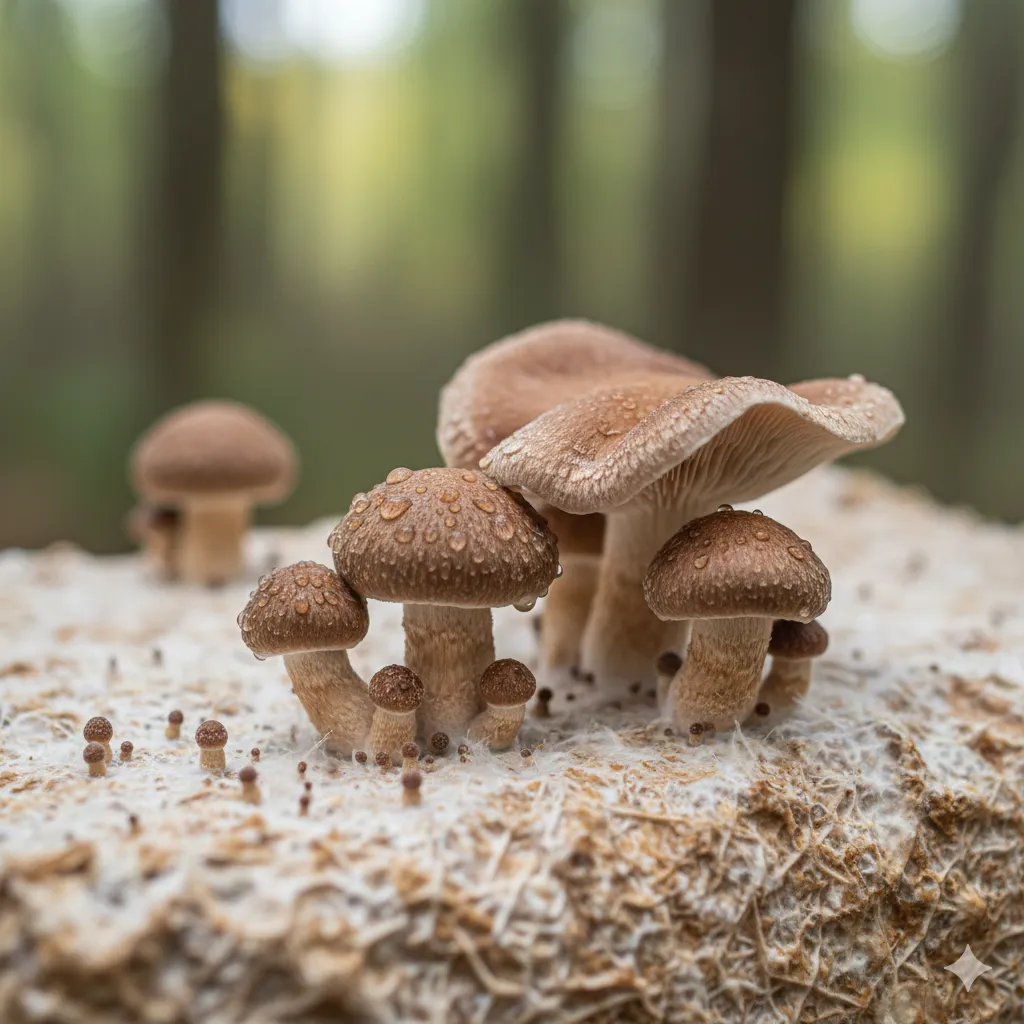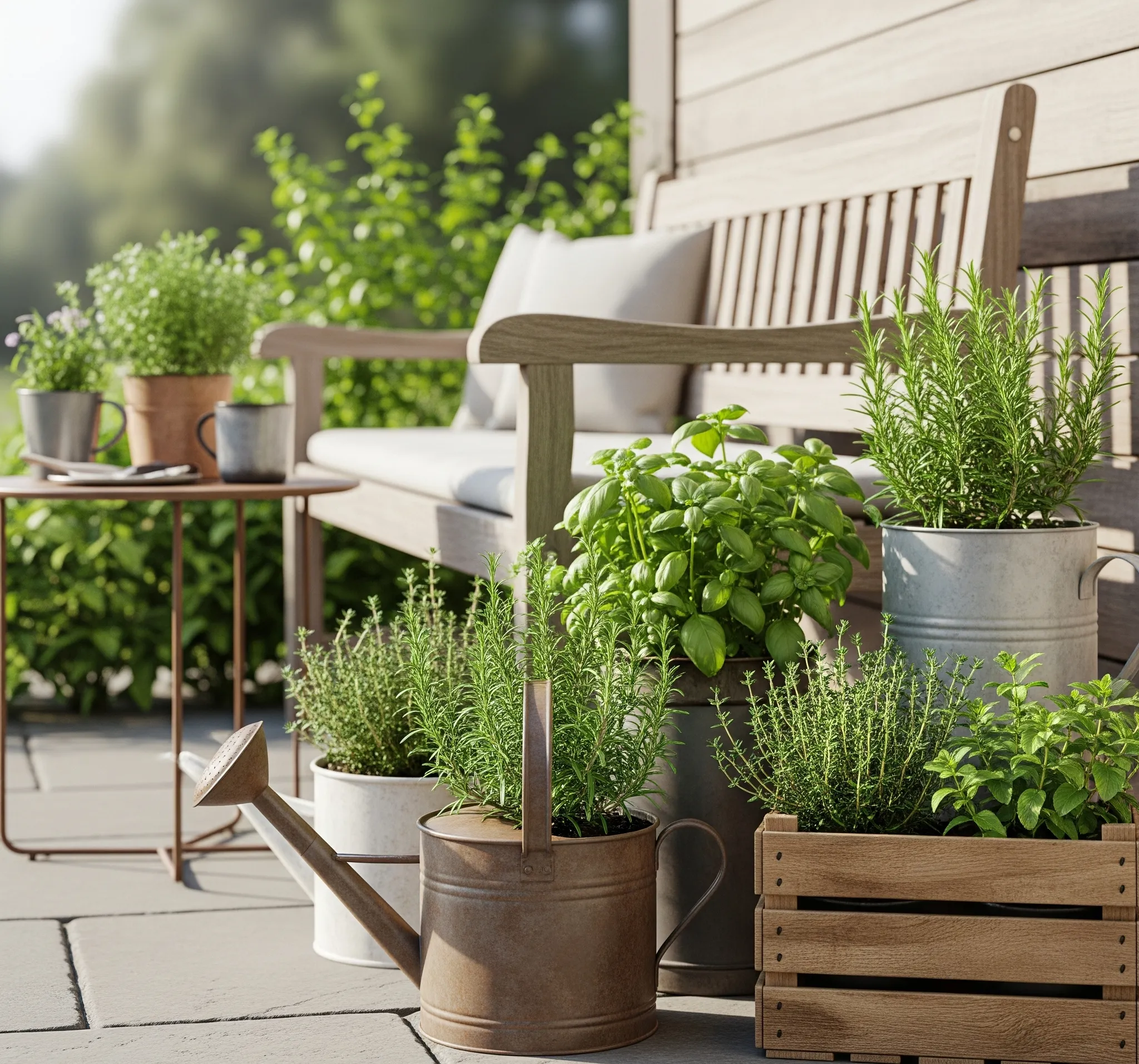Mushrooms look mysterious, but they’re ridiculously doable at home once you learn one simple indoor trick: give them the right habitat and then leave them alone. No green thumb required. No dirt.
No garden plot. Just a bag, some moisture, and a little patience. Ready to grow gourmet fungi next to your coffee maker?
Let’s do it.
The Simple Trick Gardeners Swear By

You don’t grow mushrooms like plants. You create a mini-forest floor indoors and let the fungi do the work. The trick? Bring clean, colonized substrate into a humid “fruiting chamber” and keep it moist, not soggy.
That’s it. The mycelium (the white, thread-like fungal network) handles the rest. Most people use either:
- Pre-made grow kits (the easiest path); or
- DIY sterilized substrate bags inoculated with mushroom spawn (more control, a bit more effort)
Either way, you invite fresh air, keep humidity high, and avoid direct sunlight.
The mushrooms pop out like magic in a week or two. Yes, it feels like cheating. No, you shouldn’t feel bad.
Pick Your Mushroom (Spoiler: Some Are Way Easier)
Some mushrooms demand expert-level sterilization.
Others practically grow themselves while you binge a show. Start with these:
- Oyster mushrooms (blue, pearl, pink): Fast, forgiving, and gorgeous. They love coffee grounds and straw.
- Lion’s mane: Fluffy and mild; great on hardwood sawdust blocks.
Slightly fussier but still beginner-friendly.
- Shiitake: Incredible flavor on hardwood sawdust or logs. Slower, but worth it.
FYI, button mushrooms (Agaricus) prefer composted manure and can be pickier indoors. Can you grow them?
Sure. Should you start with oysters? Absolutely.
Option A: The “Open the Box and Mist” Grow Kit

This is the best entry point. No sterilizing, no guesswork.
- Buy a kit from a reputable brand.
Pick oyster or lion’s mane for low stress.
- Cut an “X” in the bag where the instructions say. This creates a fruiting window.
- Mist 2–3 times a day and keep the bag in bright, indirect light. Not in the dark, not under a grow light sunburn.
- Maintain humidity: Place the kit in a clear plastic tote or use the included tent.
Aim for 85–95% humidity around the fruiting area.
- Harvest when caps unfurl but before they flatten completely. Twist gently or cut flush.
Expect your first flush in 7–14 days, then a second and maybe a third. You’ll feel like a wizard.
You’ll also consider growing six more kits. That’s normal.
Pro Tip: The “Bathroom Boost”
No humidifier? Put the kit in a clean bathroom and run a hot shower for a minute or two twice a day.
Don’t steam your houseplant jungle—just nudge humidity up. It works, IMO.
Option B: DIY the Substrate Bag (Still Easy, Just a Tad Nerdy)
Want more mushrooms for less money? Make your own fruiting block.
- Substrate: Hardwood sawdust or pellets + wheat bran for lion’s mane/shiitake; pasteurized straw or coffee grounds for oysters.
- Spawn: Buy grain spawn for your chosen species.
- Bags: Filter patch bags keep things clean but breathable.
Fast Methods by Mushroom Type
- Oysters on pasteurized straw
- Chop straw into 1–3 inch pieces.
- Pasteurize: Soak in 160–170°F water for 1 hour.
Drain well.
- Layer straw with grain spawn in a filter bag or bucket with 1/2 inch holes.
- Incubate at room temp (65–75°F) in the dark or indirect light until white with mycelium (7–10 days).
- Cut X slits, begin misting, and fruit.
- Lion’s mane on sawdust blocks
- Mix hardwood fuel pellets with hot water to rehydrate; add a little bran.
- Sterilize the bagged substrate in a pressure cooker (90 minutes at 15 PSI).
- Cool, then inoculate with grain spawn in as clean a space as you can manage.
- Seal, incubate until fully colonized (white and firm), then fruit with 1–2 slits.
Key idea: Cleanliness beats fancy gear. Wipe surfaces, wash hands, flame-sterilize tools, and move quickly. Contamination hates speed and alcohol wipes.
Create a Simple Fruiting Chamber
You need humidity, fresh air, and indirect light.
That’s it. Here are three easy setups:
- Martha tent: A zippered garment rack with a small humidifier and a fan on timers. Great for multiple blocks.
- Clear tote with holes: Drill 1/4 inch holes around the sides.
Mist 2–3 times daily. Simple and effective.
- Kitchen-counter kit tent: Many kits include one. Keep it clean and moist.
Aim for:
- Humidity: 85–95% during fruiting
- Temp: 60–70°F for oysters and lion’s mane (check your strain)
- Light: Bright, indirect
- Air: Light airflow; avoid stagnant corners
If the caps crack or edges dry, you need more humidity.
If stems get long and caps tiny, increase fresh air. Mushrooms speak in vibes.
Signs You’re Nailing It
- Mycelium looks white and even, not green, black, or fuzzy gray.
- Primordia (“pins”) appear as tiny bumps near your cut slits.
- Growth accelerates fast after pins form—harvest time approaches.
Harvest Like a Pro (and Get Multiple Flushes)
Harvest timing decides flavor and texture. For oysters, pick when the edges just begin to flatten, not fully horizontal.
For lion’s mane, pick when the spines elongate but before they drip. To harvest:
- Twist and pull the whole cluster gently, or slice flush with a clean knife.
- Clean the surface after harvest—remove little scraps to reduce mold.
- Rest the block 7–10 days, then soak if instructions suggest. Mist again to trigger a second flush.
Expect 2–3 flushes, each smaller than the last.
Still a big win for your kitchen and your ego.
Common Issues (And Chill Fixes)
- Green patches (Trichoderma): Remove the bag from your grow area. Don’t argue with green mold—you won’t win. Start fresh.
- Long stems, tiny caps: Increase fresh air exchange.
Crack a window or add small holes.
- Dry edges: Mist more and bump humidity. Add a small humidifier or a damp paper towel tent.
- No pins after 2 weeks: Drop temperature a few degrees, increase fresh air, and check light. Many species pin when conditions shift slightly.
- Yellowing lion’s mane: Too much light or too dry.
Soften the light and up humidity.
IMO, 90% of problems come from low humidity or low fresh air. Solve those two and watch your fungi flex.
What To Do With Your Harvest
You grew them. Now eat them like royalty.
- Oysters: Tear into strips, high-heat sear with oil until edges crisp, finish with garlic and soy.
Unreal.
- Lion’s mane: Slice into “steaks,” squeeze out moisture in the pan, then butter-baste. Tastes like lobster had a forest baby.
- Shiitake: Remove stems, sauté caps, and add to ramen or risotto. Deep umami, zero regrets.
Store mushrooms in a paper bag in the fridge for up to a week.
Dehydrate extras at low heat for long-term pantry flex.
FAQs
Do I need special lights to grow mushrooms?
Nope. Mushrooms need light cues, not photosynthesis. Bright, indirect room light works.
Avoid direct sun or blasting grow lights unless you want crispy edges.
Is growing mushrooms indoors safe?
Yes, as long as you keep things clean and toss contaminated bags immediately. You might see spores during heavy fruiting; if you’re sensitive, harvest earlier or increase ventilation.
How many mushrooms will a kit produce?
Most kits yield 1.5–3 pounds total over 2–3 flushes, depending on species, care, and your misting enthusiasm. Oysters usually give the biggest first flush.
Can I reuse the block after the last flush?
Not for indoor fruiting, but don’t trash it.
Crumble the spent block into your garden or compost. It improves soil and sometimes surprises you with outdoor mushrooms after rain. Free sequel!
What’s the best beginner species?
Oysters, every time.
They colonize fast, fruit easily, and forgive a lot of rookie mistakes. Lion’s mane is a close second for the adventurous.
Why does my bag smell funky?
Healthy mycelium smells earthy or mushroomy. Sour, sweet, or sharp odors mean contamination.
Isolate and dispose. Don’t try to salvage a smelly bag—life’s too short.
Wrap-Up: Your Countertop Can Be a Forest
If you can mist a houseplant, you can grow mushrooms. Start with a kit, keep humidity high, give them fresh air, and harvest before caps over-expand.
Then ride that second flush like a champ. Once you see a cluster of oysters burst from a bag, you’ll understand why growers swear by this simple indoor trick—it just works. Happy fruiting!


